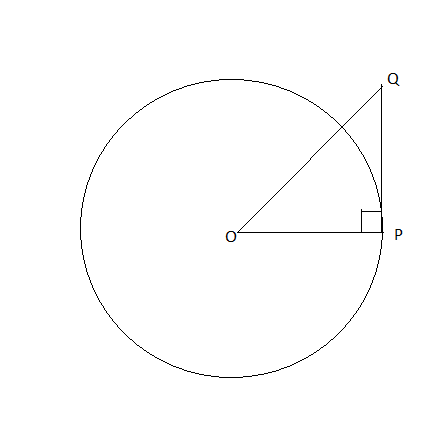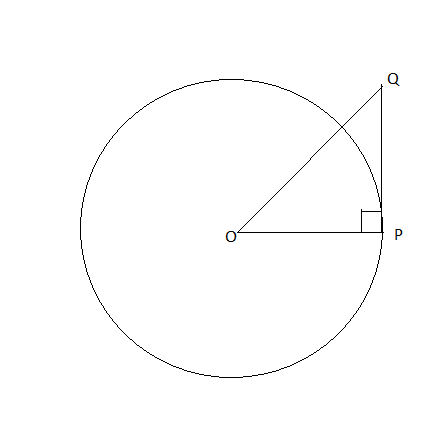
PQ is a tangent to a circle with centre O at the point P. If \[\vartriangle OPQ\] is an isosceles triangle with P as a vertex , then \[\angle OQP\] is equal to
a) \[{30^ \circ }\]
b) \[{45^ \circ }\]
c) \[{60^ \circ }\]
d) \[{90^ \circ }\]
Answer
470.7k+ views
Hint: We are given that PQ is a tangent to a circle with centre O at the point P. Let us consider OP to be the radius of the circle. Then, as PQ is tangent at point P, we know the tangent makes a right angle with the radius. Hence, \[\angle OPQ = {90^ \circ }\]. Also, we are given that \[\vartriangle OPQ\] is an isosceles triangle. We will understand this using a diagram.

In the given figure, OP is the radius of the circle and PQ is tangent at point P. Hence, \[\angle OPQ = {90^ \circ }\]. Since \[\vartriangle OPQ\] is an isosceles triangle, we have two sides of this triangle are equal. Let us consider \[OP = PQ\]. Now, we will use the property of an isosceles triangle that angles opposite to equal sides are equal. After that we will use the angle sum property of a triangle i.e. Sum of angles in a triangle is equal to \[{180^ \circ }\] and find the required angle.
Complete step-by-step solution:
Since PQ is a tangent at point P and OP is the radius of the circle.
We see it through a figure.

We know, tangent makes a right angle with the radius and So,
\[\angle OPQ = {90^ \circ } - - - - - (1)\]
As \[\vartriangle OPQ\] is an isosceles triangle with \[OP = PQ\].
We know, Angles opposite to equal sides are equal.
Angle opposite to \[PQ\] is \[\angle QOP\].
Angle opposite to \[OP\] is \[\angle OQP\].
Hence, \[\angle OQP = \angle QOP - - - - - (2)\]
In \[\vartriangle OPQ\], using Angle Sum Property
\[\angle OPQ + \angle OQP + \angle QOP = {180^ \circ } - - - - - (3)\]
Using (1) and (2) in (3)
\[{90^ \circ } + \angle OQP + \angle OQP = {180^ \circ }\]
\[ \Rightarrow {90^ \circ } + 2\angle OQP = {180^ \circ }\]
Subtracting \[{90^ \circ }\] both the sides, we get
\[ \Rightarrow {90^ \circ } + 2\angle OQP - {90^ \circ } = {180^ \circ } - {90^ \circ }\]
Clubbing the like terms on left hand side
\[ \Rightarrow 2\angle OQP + ({90^ \circ } - {90^ \circ }) = {180^ \circ } - {90^ \circ }\]
Solving the left and the right hand side
\[ \Rightarrow 2\angle OQP + {0^ \circ } = {90^ \circ }\]
\[ \Rightarrow 2\angle OQP = {90^ \circ }\]
Dividing both the sides by \[2\].
\[\dfrac{{2\angle OQP}}{2} = \dfrac{{{{90}^ \circ }}}{2}\]
\[\angle OQP = {45^ \circ }\]
Hence, we got \[\angle OQP = {45^ \circ }\].
Therefore, the correct option is (b).
Note: We need to be very thorough with the properties of circles and triangles. Once we interpret the given question, we need to think of the steps of solving the problem. While solving, we need to take care of the calculations. We have to read the question carefully and then draw the figure and then apply the properties. Each and every detail in the question needs to be read very carefully. While solving, we have to take care of each and every step.

In the given figure, OP is the radius of the circle and PQ is tangent at point P. Hence, \[\angle OPQ = {90^ \circ }\]. Since \[\vartriangle OPQ\] is an isosceles triangle, we have two sides of this triangle are equal. Let us consider \[OP = PQ\]. Now, we will use the property of an isosceles triangle that angles opposite to equal sides are equal. After that we will use the angle sum property of a triangle i.e. Sum of angles in a triangle is equal to \[{180^ \circ }\] and find the required angle.
Complete step-by-step solution:
Since PQ is a tangent at point P and OP is the radius of the circle.
We see it through a figure.

We know, tangent makes a right angle with the radius and So,
\[\angle OPQ = {90^ \circ } - - - - - (1)\]
As \[\vartriangle OPQ\] is an isosceles triangle with \[OP = PQ\].
We know, Angles opposite to equal sides are equal.
Angle opposite to \[PQ\] is \[\angle QOP\].
Angle opposite to \[OP\] is \[\angle OQP\].
Hence, \[\angle OQP = \angle QOP - - - - - (2)\]
In \[\vartriangle OPQ\], using Angle Sum Property
\[\angle OPQ + \angle OQP + \angle QOP = {180^ \circ } - - - - - (3)\]
Using (1) and (2) in (3)
\[{90^ \circ } + \angle OQP + \angle OQP = {180^ \circ }\]
\[ \Rightarrow {90^ \circ } + 2\angle OQP = {180^ \circ }\]
Subtracting \[{90^ \circ }\] both the sides, we get
\[ \Rightarrow {90^ \circ } + 2\angle OQP - {90^ \circ } = {180^ \circ } - {90^ \circ }\]
Clubbing the like terms on left hand side
\[ \Rightarrow 2\angle OQP + ({90^ \circ } - {90^ \circ }) = {180^ \circ } - {90^ \circ }\]
Solving the left and the right hand side
\[ \Rightarrow 2\angle OQP + {0^ \circ } = {90^ \circ }\]
\[ \Rightarrow 2\angle OQP = {90^ \circ }\]
Dividing both the sides by \[2\].
\[\dfrac{{2\angle OQP}}{2} = \dfrac{{{{90}^ \circ }}}{2}\]
\[\angle OQP = {45^ \circ }\]
Hence, we got \[\angle OQP = {45^ \circ }\].
Therefore, the correct option is (b).
Note: We need to be very thorough with the properties of circles and triangles. Once we interpret the given question, we need to think of the steps of solving the problem. While solving, we need to take care of the calculations. We have to read the question carefully and then draw the figure and then apply the properties. Each and every detail in the question needs to be read very carefully. While solving, we have to take care of each and every step.
Recently Updated Pages
Explain the double helix structure of DNA with a labeled class 10 biology CBSE

State and prove converse of BPT Basic Proportionality class 10 maths CBSE

Which party gave the slogan Save Democracy in the Lok class 10 social science CBSE

iWhat is Rain Water Harvesting iiWhat are the advantages class 10 social science CBSE

Explain any 5 effects of the Russian Revolution of class 10 social science CBSE

Refractive index of glass with respect to water is class 10 physics CBSE

Trending doubts
Why is there a time difference of about 5 hours between class 10 social science CBSE

Tropical deciduous trees shed their leaves in the dry class 10 social science CBSE

The Equation xxx + 2 is Satisfied when x is Equal to Class 10 Maths

Write a letter to the principal requesting him to grant class 10 english CBSE

The uses of bleaching powder are A It is used bleaching class 10 chemistry CBSE

Leap year has days A 365 B 366 C 367 D 368 class 10 maths CBSE




